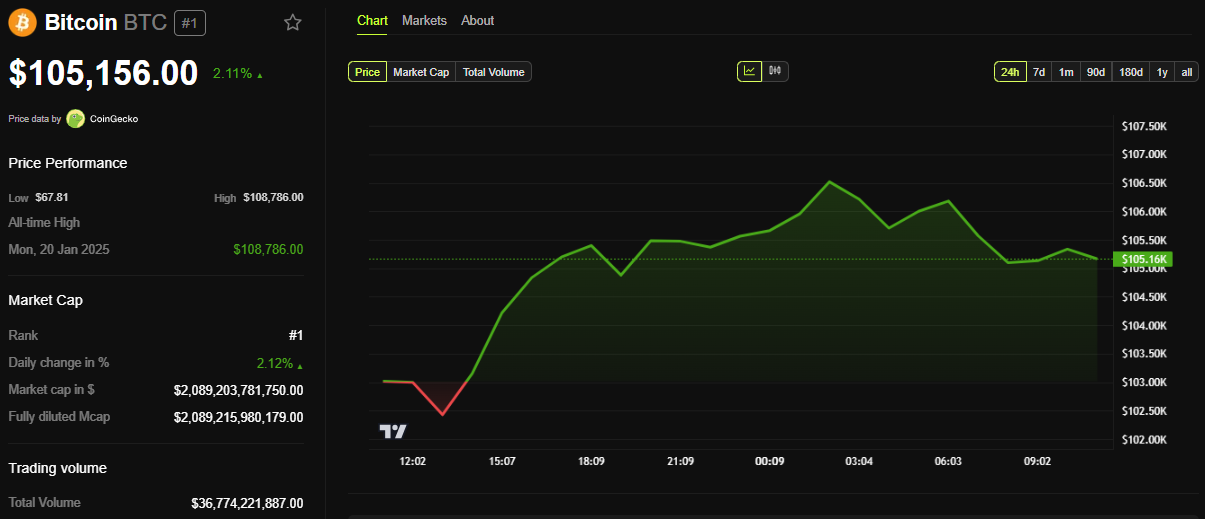How PBOC Rate Cuts and US Credit Downgrade Benefit Bitcoin

Macroeconomic tremors from China and the US have put Bitcoin (BTC) in the spotlight, offering fertile ground for its narrative as a hedge against traditional finance (TradFi) instability.
The influence of macroeconomic factors and forces on Bitcoin has escalated from 2024 to 2025, after a period when it dissipated in 2023.
Bitcoin Gains from China’s Rate Cut and US Credit Downgrade
On Tuesday, the People’s Bank of China (PBOC) cut its benchmark lending rates for the first time in seven months. Specifically, it lowered the 1-year Loan Prime Rate (LPR) from 3.10% to 3.00% and the 5-year LPR from 3.60% to 3.50%.
The move injects fresh liquidity into global markets. It aims to stimulate a sluggish economy weighed down by weak domestic demand and bolster a shaky property sector, all amid recent trade tensions with the US.
“The PBOC cut… to support the economy amid slowing growth and US trade pressures. Essentially, this injects additional momentum into risk assets by providing cheaper liquidity and fostering a risk-on sentiment,” noted Axel Adler Jr., an on-chain and macro researcher.
While China’s easing measures aim to boost local borrowing and spending, they may also spill over into global asset markets, including crypto.
Often viewed as a high-beta asset, Bitcoin typically benefits from such liquidity tailwinds. This is especially true when coupled with fiat weakening or broader economic instability.
Simultaneously, the US faces its own credibility crisis. Moody’s downgraded the US sovereign credit rating from AAA to AA1. It cited persistent fiscal deficits, ballooning interest expenses, and a projected federal debt burden of 134% of GDP by 2035.
This marks only the third major downgrade in US history, following similar moves by Fitch in 2023 and S&P in 2011. Nick Drendel, a data integrity analyst, highlighted the pattern of volatile market reactions following previous downgrades.
“[The Fitch downgrade in 2023] led to a 74 trading day (-10.6%) correction for the Nasdaq before closing above the close from before the downgrade,” Drendel noted.
This downgrade mirrors those concerns amid massive debt, political gridlock, and rising default risk.
Moody’s Downgrade, US Fiscal Woes Boost Bitcoin’s Safe-Haven Appeal
On-chain analyst Adler points out that the market’s reaction was swift. The US Dollar Index (DXY) weakened to 100.85, while gold rose 0.4%, signaling a classic flight to safety.
Bitcoin, frequently dubbed digital gold, saw renewed interest as a non-sovereign store of value.
“…despite the prevailing ‘risk-off’ sentiment… Bitcoin may find itself in a relatively stronger position in the current environment due to its “digital gold” narrative and the supportive effect of a weaker dollar,” Adler noted.
Ray Dalio, founder of Bridgewater Associates, criticized credit ratings for underplaying the broader monetary risks.
“…they only rate the risk of the government not paying its debt. They don’t include the greater risk that countries in debt will print money to pay their debts, thus causing holders of the bonds to suffer losses from the decreased value of the money they’re getting (rather than from the decreased quantity of money they’re getting),” Dalio warned.
Against this backdrop, Dalio concludes that the risks for US government debt are greater than the rating agencies are conveying.
Echoing that sentiment, economist Peter Schiff argued that inflation risk should be front and center when rating sovereign debt. In his opinion, this is especially true when foreign investors who lack political leverage hold much of it.
“…when a nation owes a lot of debt to foreigners, who can’t vote, the odds of a default on foreign-owned debt should be factored in,” he noted.
The dual macro shifts, China injecting liquidity and the US showing fiscal cracks, present Bitcoin with a unique tailwind. Historically, BTC has thrived under similar conditions – rising inflation fears, weakened fiat credibility, and global capital looking for resilient alternatives.
Though markets remain volatile, the confluence of dovish Chinese policy and renewed doubts about US fiscal discipline could drive institutional and retail investors toward decentralized assets like Bitcoin.
If the dollar continues to lose appeal and central banks adopt easier policies, Bitcoin’s value proposition as a politically neutral, non-inflationary asset will become harder to ignore.

BeInCrypto data shows BTC was trading for $105,156 as of this writing. This represents a modest 2.11% surge in the last 24 hours.
Disclaimer
In adherence to the Trust Project guidelines, BeInCrypto is committed to unbiased, transparent reporting. This news article aims to provide accurate, timely information. However, readers are advised to verify facts independently and consult with a professional before making any decisions based on this content. Please note that our Terms and Conditions, Privacy Policy, and Disclaimers have been updated.



